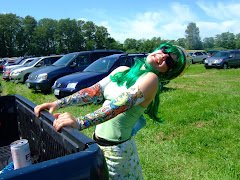 A friend asked me recently how many hours a week I spend reading--this after a visit to my upstairs bathroom/library--and I approximated that I read about 10 hours a week. Afterward, I realized that I might have exaggerated--10 hours is over an hour a day--but then I thought about a typical day's reading: twenty minutes in the morning while I drink coffee and procrastinate about exercising; 20-30 minutes at work; and then I fall asleep each night after 20-30 minutes of bedtime reading.
A friend asked me recently how many hours a week I spend reading--this after a visit to my upstairs bathroom/library--and I approximated that I read about 10 hours a week. Afterward, I realized that I might have exaggerated--10 hours is over an hour a day--but then I thought about a typical day's reading: twenty minutes in the morning while I drink coffee and procrastinate about exercising; 20-30 minutes at work; and then I fall asleep each night after 20-30 minutes of bedtime reading.Of the time I spend reading, about two-thirds is devoted to non-fiction, which is a dramatic reversal from just 10 years ago, when I read fiction almost exclusively. I credit the change to the rise in popularity and quality of memoirs, as well as the range of fascinating topics being approached by entertaining, funny writers like Sarah Vowell, Mary Roach, and Malcom Gladwell.
I still read fiction,of course, although I try to avoid the bestsellers since
 one of my purposes as a reader is to discover, read, and recommend books that others (especially my students) might not find or hear about on their own. Hence my excuse for not reading most of the Harry Potters or any of the Twilight books.
one of my purposes as a reader is to discover, read, and recommend books that others (especially my students) might not find or hear about on their own. Hence my excuse for not reading most of the Harry Potters or any of the Twilight books. Anita Shreve is pretty well known, since her books have been picked by Oprah and made into movies. Nevertheless, she also writes about my favorite topics: disappearances and scandal! And her new novel, Testimony, is no exception. At an elite private boarding school, a scandal erupts when a videotape surfaces of a group of students having sex in a campus dorm room.
As the story of the night on tape unfolds, it becomes clear that there is more to the events in question than a group of drunk teenagers with access to a video camera. Told from the various perspectives of characters involved in or affected by the events in question, this story is gripping and highly readable, even as it is disturbing--not just because of what the teens themselves did, but because of how the adults in their lives are culpable for what they did and what happened afterward.
Fast-paced fiction of the kind Shreve is known for (The Pilot's Wife, The Last Time They Met, Eden Close) appeals to me not just for the escapist, entertaining value of it, but because contemporary fiction like Testimony keeps us in touch with the cultural zeitgeist. (And yes, I wrote that so I could use the word zeitgeist.) I think that's worth a few minutes a day.












